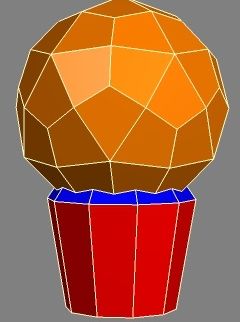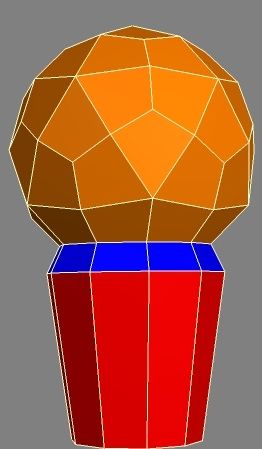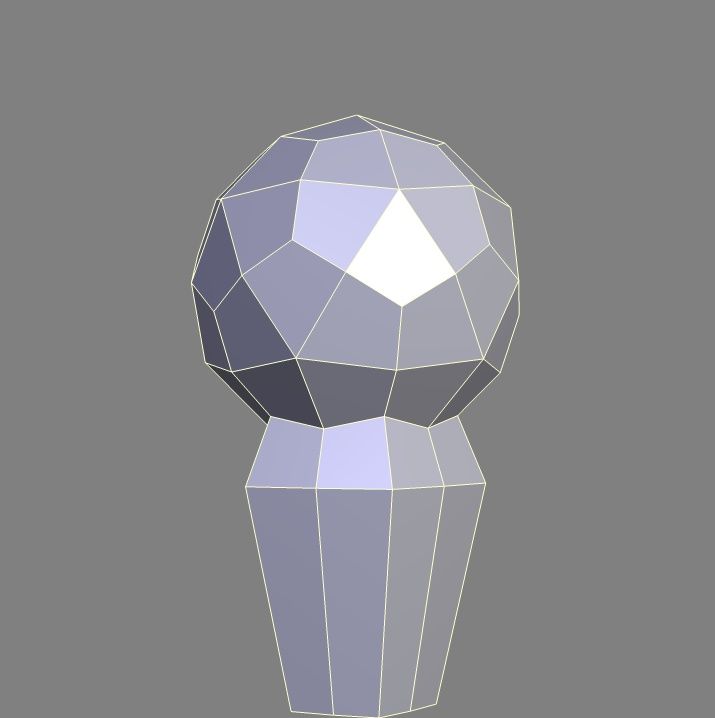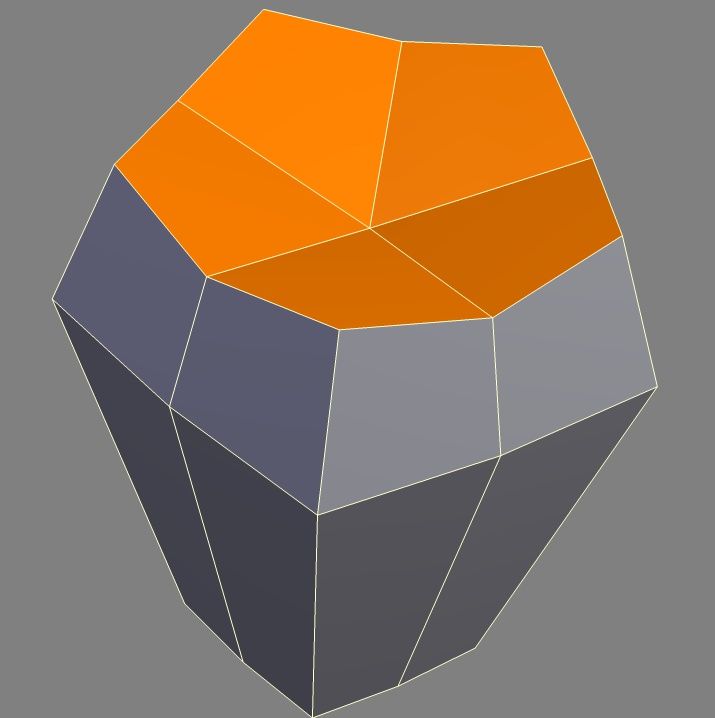Hi there,
I'm new to Great Stella. I have a specific goal in mind, but after reading the documentation, I'm not clear on how to accomplish it, and am hoping I can get some help from you.
I'm designing a sculpture and want to spit out nets that I can send to the metal shop fabricating it. However, the shape is a bit odd. Here's what it looks like now:
http://mitchvandusen.com/shape.jpg
Here's what I'd like to do:
1. The top shape is a johnson solid: trapezoidal hexacontahedron. My desire is to slice off a part of the bottom, and create two polyhedrons emanating from whatever shape/face is left on the bottom after the cut.
2. I know you can add polyhedron to any other polyhedron, but I am unclear how to make the specific shape I'm talking about, both with the adjustments to the main johnson solid, and with an appropriate polyhedron coming out of the base. If i could at least output the top/main polyhedron and the bottom polyhedron, I would be happy and can work with that.
3. I want to scale it up, but what are the dimensions that scaling is measured in? Neither the manual, nor the actual software input specify.
I know this is long, so I'll sum it up:
1. How do I slice off a part of the top/main polyhedron?
2. How to I create a second (and ideally third) polyhedron emanating down from that?
3. What measurements are the scaling options measured in?
THANK YOU!!!!!!
Mitch
Help Please! How do I do this...
- robertw
- Site Admin
- Posts: 723
- Joined: Thu Jan 10, 2008 6:47 am
- Location: Melbourne, Australia
- Contact:
Hi Mitch,
Let me start with question 3. The "Scale->Distance Units" submenu lets you choose what units you are using (centimetres by default).
Question 1. The trapezoidal hexacontahedron is a Catalan solid, by the way, not a Johnson solid. That is it's a dual of one of the Archimedean solids.
When you mention slicing the bottom off, do you really want a straight cut, or do you wish to maintain the surrounding face shapes? If you remove the bottom 5 trapezoids, the 10 edges around the resulting hole don't lie in a single plane, so if you want to retain the surrounding face shapes, simply slicing won't quite do it.
For now let's presume you are happy to slice with a plane though. There's no direct operation in Stella for doing this (something for the to-do list!), but it can be done in various round-about ways. One way would be to add the shape to another shape which has the facial planes required for the slicing, making sure they have the appropriate relative scale to put those planes where you want. Then use stellation to carve what we need out from the resulting planes.
For example, let's slice the bottom off using a plane through the deeper set of 5 vertices around the bottom 5 trapezoids (remember how the 10 edges didn't lie in a plane? Well 5 vertices lie in one plane and 5 in another plane). These are the vertices where 3 edges meet. We need an extra facial plane through those vertices. A dodecahedron would do the job. So follow these steps:
Onto question 2: it depends what shape you want to add, but it looks like maybe you just want to add a prism or podium, which may be done easily as follows:

Let me start with question 3. The "Scale->Distance Units" submenu lets you choose what units you are using (centimetres by default).
Question 1. The trapezoidal hexacontahedron is a Catalan solid, by the way, not a Johnson solid. That is it's a dual of one of the Archimedean solids.
When you mention slicing the bottom off, do you really want a straight cut, or do you wish to maintain the surrounding face shapes? If you remove the bottom 5 trapezoids, the 10 edges around the resulting hole don't lie in a single plane, so if you want to retain the surrounding face shapes, simply slicing won't quite do it.
For now let's presume you are happy to slice with a plane though. There's no direct operation in Stella for doing this (something for the to-do list!), but it can be done in various round-about ways. One way would be to add the shape to another shape which has the facial planes required for the slicing, making sure they have the appropriate relative scale to put those planes where you want. Then use stellation to carve what we need out from the resulting planes.
For example, let's slice the bottom off using a plane through the deeper set of 5 vertices around the bottom 5 trapezoids (remember how the 10 edges didn't lie in a plane? Well 5 vertices lie in one plane and 5 in another plane). These are the vertices where 3 edges meet. We need an extra facial plane through those vertices. A dodecahedron would do the job. So follow these steps:
- Start with the trapezoidal hexacontahedron. If you're looking at it in the Dual view, then use the left-and-down arrow button at the top of that view to convert it to a base model, then switch to the standard Base view.
- We will need to match scale, so enter Measurement mode.
- Shift+Left-click on one of the vertices where 3 edges meet.
- Click the circle-with-a-dot-in-the-middle button at the top of the view (if it's not there, then you're not in Measurement mode).
- This should tell you the distance between the model's centre at a 3-valent vertex. Use "Scale->Measured Distance" to edit this to something you'll remember, eg "1".
- Remember to leave Measurement mode (just hit Esc).
- Put the model in a memory slot, eg type "m1".
- Now load a dodecahedron (eg type Ctrl+N d <Enter>)
- Set its radius to the same as set above, eg "1", using "Scale->Base Polyhedron Radius".
- Add the two models together using "Edit->Add/Blend from Memory".
- Now it just looks like the trapezoidal hexacontahedron again, but a dodecahedron is hiding inside. You can explode the faces apart a bit to see this (Ctrl+Shift+Left-drag, and Ctrl+Shift+Right-click to snap back together).
- Display the symmetry axes to make the next steps clearer (hit "s").
- From the symmetry group drop-down box (currently showing "Icosahedral") select "5-fold pyramidal". You'll see most of the symmetry axes disappear.
- Switch to a stellation view.
- Select one of the faces touching the remaining symmetry axis.
- Use "Selection->Selected Face Display->Show Stellation Diagram" (or the matching toolbar button) to display the stellation diagram on the selected face.
- You'll see red parts where the face is. Shift+Left-click on the two different types of red area to remove the 3D stellation cells beneath them.
- Now you have the sliced shape! You probably want to hide the stellation diagram again ("Selection->Selected Face Display->Highlight").
- Use the left-and-down arrow button at the top of the view to make this the new base model. Then switch back to the normal base view.
Onto question 2: it depends what shape you want to add, but it looks like maybe you just want to add a prism or podium, which may be done easily as follows:
- Select the big face where we sliced the model.
- Use "Poly->Augment Polyhedron" (or hit "a").
- Select "Prism" and hit Enter.
- A preview of the augmentation will appear, showing a prism added to the face.
- While previewing, use Ctrl+Left-drag to interactively make the prism taller or shorter.
- ...and use Ctrl+Right-drag to interactively make the base of the prism wider or narrower.
- In your case, based on your picture, you might make this first prism not too tall, and a bit wider at the base. Hit Enter when you're happy with your adjustments.
- Then select the new big face at the bottom of the prism, and repeat. Use augmentation again to add another prism, this time make it taller, and make the base narrower.

THANKS ROBERT!
I will give it a go and get back to you. As for slicing all the way through, I understand what you're saying. Honestly, I don't know if my design would work off the top of my head if we kept all the faces in full form. I'll take a look.
Thank you so much for your extensive reply!
Mitch
I will give it a go and get back to you. As for slicing all the way through, I understand what you're saying. Honestly, I don't know if my design would work off the top of my head if we kept all the faces in full form. I'll take a look.
Thank you so much for your extensive reply!
Mitch
Re: Help Please! How do I do this...
Mitch,
this is another way to get to it, perhaps a little bit faster:
You first construct a base model, starting from a 10-fold prism and using the
augmentation techniques Robert described:

Then you put the trapezoidal hexecontahedron into a memory and select the
top vertex of the base you constructed before. You choose the "put models
on faces/vertices-tool" and apply it to that vertex and the model in the
memory. You have to fiddle the size and the depth a bit until you get it like
this:

Here, the "perpendicular" edges of both models are not in coinciding planes
which looks even better imho.
After subdividing the faces by 2 you can facet new faces to get those edges
in coplanar planes:

If you want to keep only the facelets on the surface, you choose the
stellation view, put the model into a memory, retrieve it back again and go
back to the normal view.
Ulrich
this is another way to get to it, perhaps a little bit faster:
You first construct a base model, starting from a 10-fold prism and using the
augmentation techniques Robert described:

Then you put the trapezoidal hexecontahedron into a memory and select the
top vertex of the base you constructed before. You choose the "put models
on faces/vertices-tool" and apply it to that vertex and the model in the
memory. You have to fiddle the size and the depth a bit until you get it like
this:

Here, the "perpendicular" edges of both models are not in coinciding planes
which looks even better imho.
After subdividing the faces by 2 you can facet new faces to get those edges
in coplanar planes:

If you want to keep only the facelets on the surface, you choose the
stellation view, put the model into a memory, retrieve it back again and go
back to the normal view.
Ulrich
Unfortunately that doesn't work because the four vertices you need arerobertw wrote:... Doing it your way also means that you could facet
using the original vertices of the trapezoidal hexacontahedron to keep
the original face shapes around the bottom.
Rob.
not lying in a plane. I had to take the stellation vertices.
To keep those kites in their original shape you can construct it using
augmentation and faceting techniques. The result is better:

It's a rather lengthy procedure, starting with augmentating the bottom
group of 5 kites of the hexecontahedron by prisms. These are augmented
at their lateral faces by prisms again. At the point where each two edges
of these prisms intersect, I have a fourth coplanar point to form the base
model's top row of (distorted) kites by faceting:

Stel-file on request
